Amnio alcohol esters
a.clidinium bromide ( cinipox)
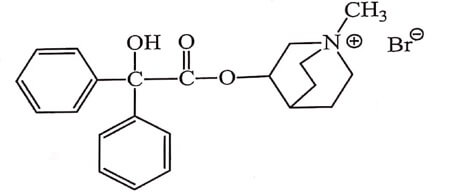
3-[(2-Hydroxy-2,2-diphenylacetyl)oxy]-1-methyl-1-azabicyclo[2.2.2]octan-1-ium bromide
Mechanism of Action: It inhibits muscarinic actions of acetylcholine at postganglionic parasympathetic neuro effector sites primarily by inhibiting the M1 muscarinic receptors.
Use: It is used as anticholinergic agent, in combination with minor tranquillizer Chlordiazepoxide. It is used for peptic ulcer, hyperchlorhydria and ulcerative or spatic colon.
B.CYCLOPENTOLATE HYDROCHLORIDE (CYCLOGIK)

2-(Dimethylamino) ethyl (1- hydroxy cyclopentyl) (phenyl) acetate
Mechanism of Action: It blocks muscarinic receptors and produces dilatation of the pupil (mydriasis) and prevents the eye from accommodating for near vision (cycloplegia).
Use: It is used as mydriatic agent.
c.dicyclomine HYDROCHLORIDE (colimex)

2-(Diethyl amino) ethyl bicyclohexyl -1- carboxylate hydrochloride
Synthesis

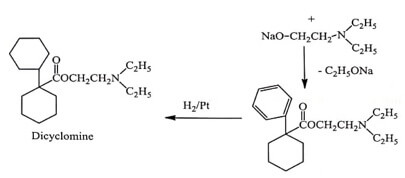
Mechanism of action: It inhibits acetylcholine’s muscarinic actions at postganglionic parasympathetic receptors in smooth muscles, secretory glands and the CNS. These actions relax smooth muscles.
Use: It is also used in dysmenorrhea, pylorospasm and biliary dysfunction.
D. Glycopyrrolate (Cuvposa)

3 – Hydroxy -1, 1-dimethyl pyrrolidium -α- cyclopentyl mandelate
Mechanism of action: It inhibits acetylcholine’s action on postganglionic muscarinic receptors throughout the body. It produces reduction in the volume and acidity of gastric secretions and control the excessive bronchial, pharyngeal and tracheal secretions and dilating the bronchi.
Use: It is used for suppressing gastric secretion and in the treatment of peptic ulcer and GI disorders associated with spasm.
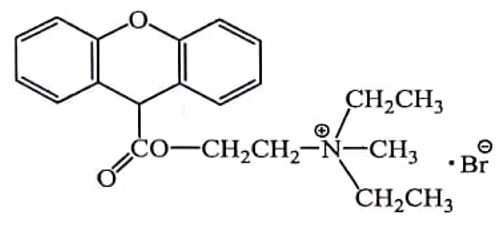
N- Methyl – N – ethyl – N – {2 – [ 9H – xanthene – 9 – yl carbonyl) oxy] ethyl } – 2 – ethyl ammonium bromide
Mechanism of action: It inhibits the muscarinic actions of acetylcholine. Depending on the dose, anticholinergics may reduce the motility and secretory activity of the gastrointestinal system and the tone of the ureter and urinary bladder and may have a slight relaxant action on the bile ducts and gallbladder.
Use: It is a potent anticholinergic agent and acts on nicotinic cholinergic receptor.
F. Propantheline bromide (Spastheline)

Mechanism of action: It is an anticholinergic drug that reduces the effect of acetylcholine, a chemical released from nerves that stimulates muscles, by blocking the receptors for acetylcholine on smooth muscle (a type of muscle). It also has a direct relaxing effect on smooth muscle.
Use: It is used as antispasmodic and in the treatment of peptic ulcer.
Amino Alcohol Ethers
A. Benztropine mesylate (Cogentin)
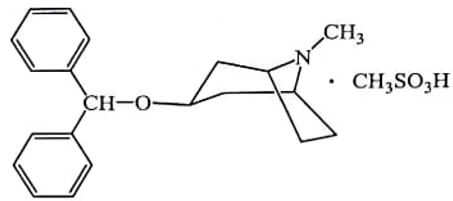
3α – (Diphenyl methoxy) – 1αH, 5αH- tropane methane sulfonate
Mechanism of action: It blocks acetylcholine’s action at cholinergic receptor sites. This restores the brain’s normal dopamine and acetylcholine balance, which relaxes muscle movement and decreases drooling, rigidity and tremor. It also inhibit dopamine reuptake and storage, which prolongs dopamine’s action.
Use: It has anticholinergic, antihistaminic and local anaesthetic activities. It is used in the treatment of Parkinson’s disease.
B. Orphenadrine citrate (Norflex)
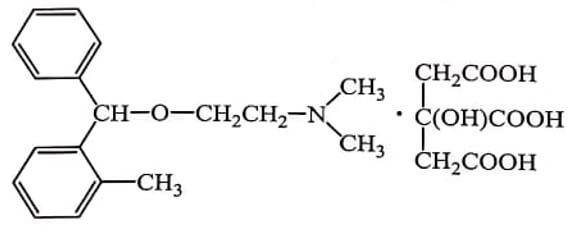
N, N – Dimethyl – 2 – (o – methyl – α-phenyl benzyloxy) ethylamine citrate
Mechanism of action: It reduces muscle spasms by acting on cerebral motor centers or medulla. Postganglionic anticholinergic effects and some antihistaminic and local anesthetic action contribute to skeletal muscle relaxation.
Use: It is used for the symptomatic treatment of Parkinson’s disease. It is also used as skeletal muscle relaxant.
Amino Alcohols
A. Biperiden hydrochloride (Akineton)
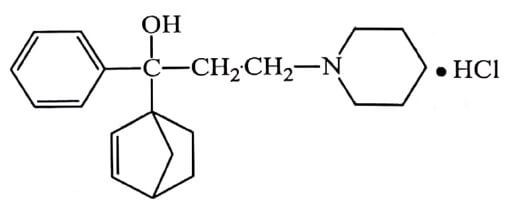
5α- Norbornen – 2 – yl – α – phenyl – 1 – piperidine propanol hydrochloride
Mechanism of action: It blocks acetylcholine’s action at cholinergic receptor sites. This action restores the brain’s normal dopamine and acetylcholine balance, which relaxes muscle movement and decreases rigidity and tremors. It also inhibits dopamine reuptake and storage, which prolongs dopamine’s action.
Use: It is used in all types of Parkinson’s disease.
B. Procyclidine hydrochloride (Kemadrin)
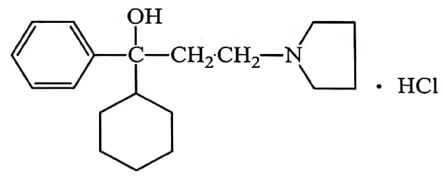
1- Cyclohexy -1- phenyl -3- pyrrolidin – 1- yl-1- propanol hydrochloride
Synthesis

Mechanism of action: It acts by blocking central cholinergic receptors and thus balancing cholinergic and dopaminergic activity in the basal ganglia. It’s antispasmodic effects are thought to be related to the blockage of central cholinergic receptors M1, M2 and M4.
Use: It is used in the treatment of Parkinson’s disease.
C. Tridihexethyl chloride (Pathilon)

(R)-1-cyclohexyl-1-phenyl-3-(piperidin-1-yl)propan-1-ol hydrochloride
Mechanism of action: It binds to muscarinic acetylcholine receptor. It may block all three types of muscarinic receptors including M-1 M-2 and M-3 receptors.
Use: It is used in the treatment of Parkinson’s disease and also used as an antispasmodic.
Amino Amides
A. Isopropamide iodide (Gastabid)
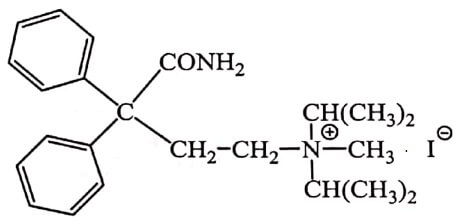
(3 – Carbamoyl – 3, 3 – diphenyl propyl) – diisopropyl methyl ammonium iodide
Mechanism of action: It inhibits parasympathetic nerve impulses by selectively blocking the binding of the neurotransmitter acetylcholine to its receptor in nerve cells.
Use: It is a potent anticholinergic drug. It has antispasmodic and antisecretory effects. It is used in the treatment of peptic ulcer. It is given along with Trifluperazine.
B. Tropicamide (Mydriacyl)

N – Ethyl – 3 – hydroxy – 2 – phenyl – N- (pyridin – 4 – yl methyl) propanamide
Mechanism of action: It blocks the receptors in the muscles of the eye (muscarinic receptor M4). It also acts by blocking the responses of the iris sphincter muscle to the iris and ciliary muscles to cholinergic stimulation, producing dilation of the pupil and paralysis of the ciliary muscle.
Use: It is used to dilate pupil for an eye examination and other ophthalmologic practices.
Miscellaneous
A. Ethopropazine hydrochloride (Parsidol)
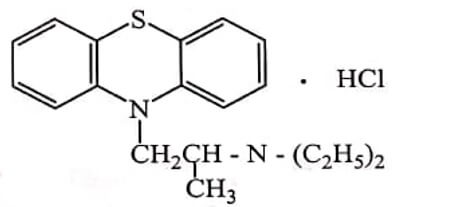
10 – [2 – (Diethyl amino) propyl] phenothiazine hydrochloride
Mechanism of action: It partially blocks central cholinergic receptors, thereby helping to balance cholinergic and dopaminergic activity in the basal ganglia; salivation may be decreased and smooth muscle may be relaxed. Its local anesthetic effect is due to its antagonism of the NMDA glutamate receptor.
Use: It is useful in the symptomatic treatment of Parkinsonism.
| Read More Topics |
| Ionization and pKa value |
| Tissue permeability of drugs |
| Hydrogen bonding and biological action |





